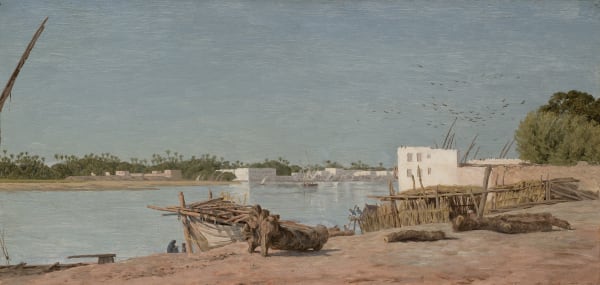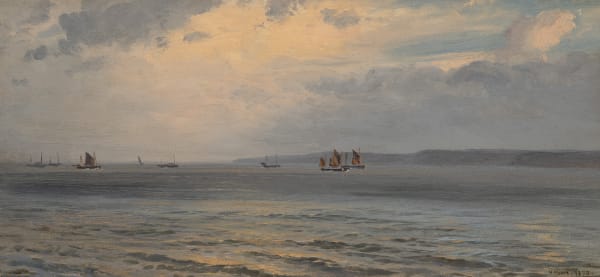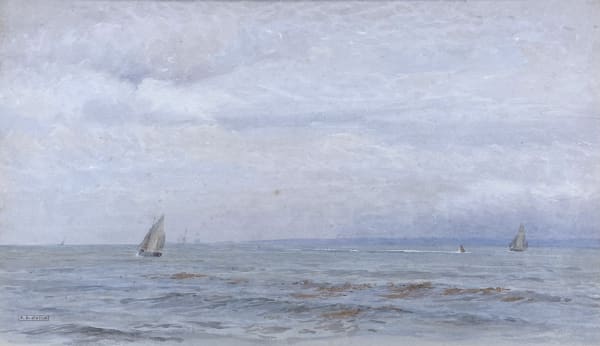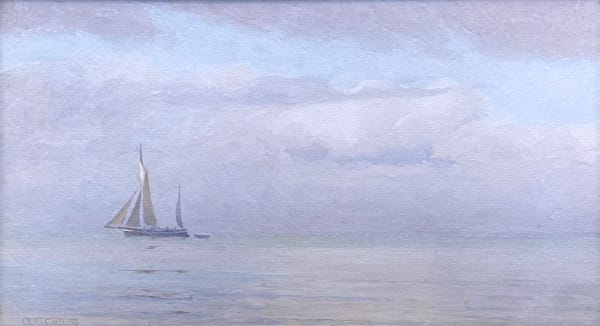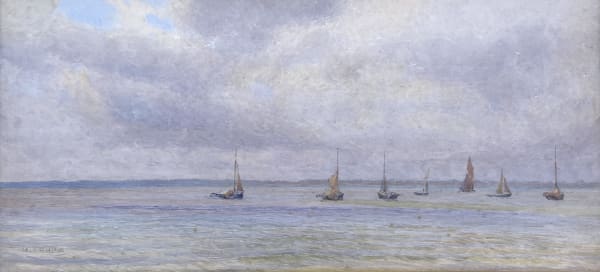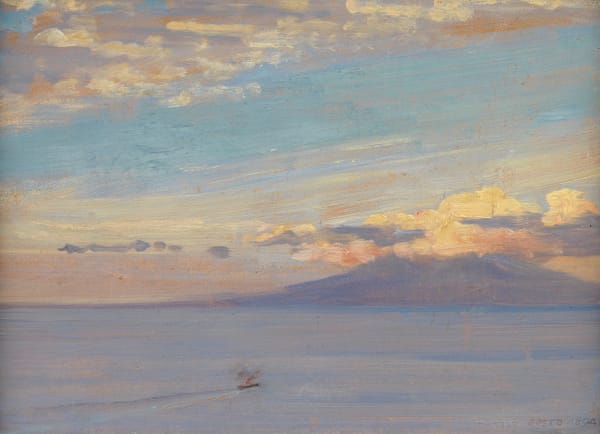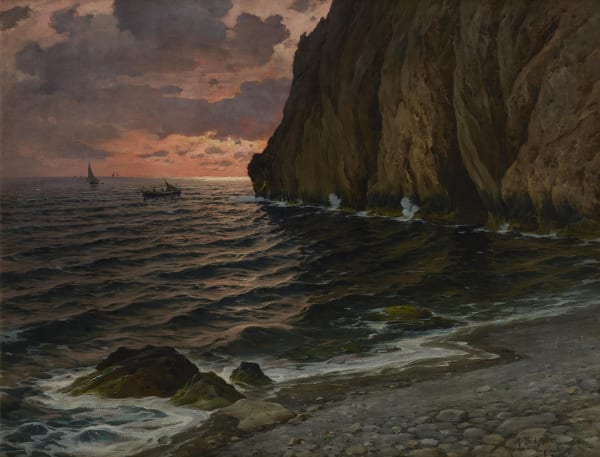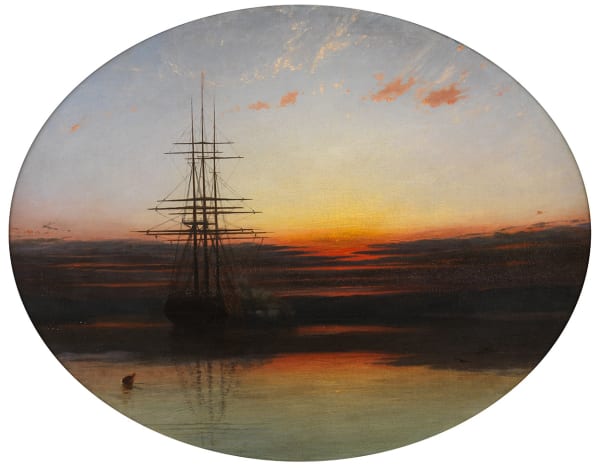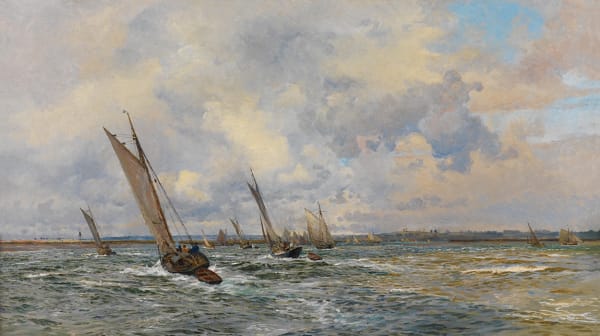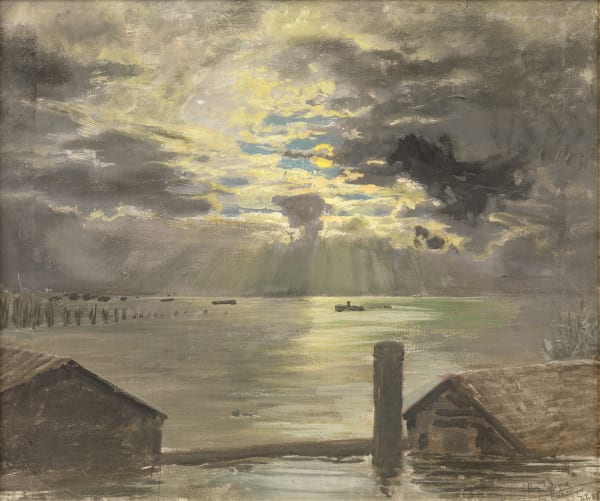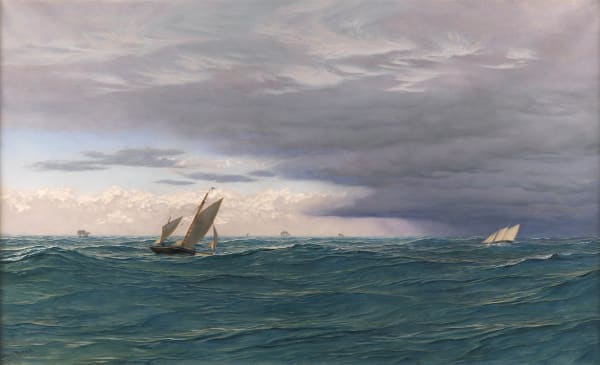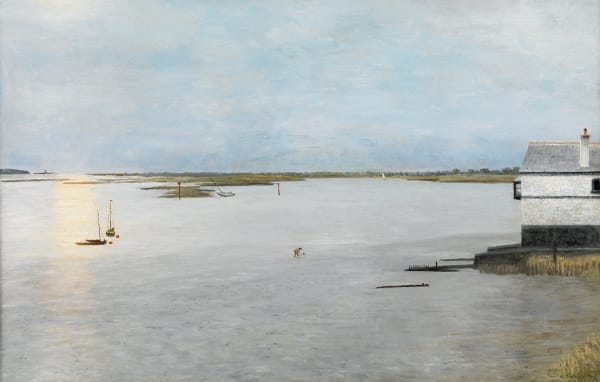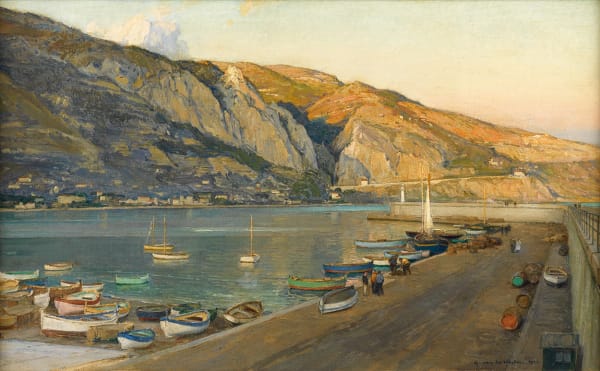Harry van der Weyden (1868-1952)
Van der Weyden was born in Boston, and won a scholarship to the Slade School in London at age nineteen. He then studied at the Académie Julien in Paris in 1890-1891, and was one of a number of American artists living and working in Paris, including Sargent, Whistler, Cassatt, and Homer. He exhibited at the Paris Exposition of 1900, which the New York Times described as 'unquestionably the finest collection of works by American artists that ever before has been brought together'.
Van der Weyden lived near Etaples at Montreuil-sur-Mer on the Normandy coast, but at the outbreak of the war in 1914, he left France together with his two elder sons, Hal (aged 19) and Erik (aged 17). The three men tried to join the British Army as American citizens. When advised to 'think again' by an army recruiter in England, the trio went outside to discuss, and then returned claiming they were British subjects. They were accepted. Harry's house at Montreuil, in Allied territory, became something of a home from home to British officers from Haig's GHQ. Harry’s regiment was the Royal Engineers and they put his artistic skills to work, making him camouflage officer, while Hal joined the Royal Fusiliers, and was awarded the MC, and Erik joined the Royal Flying Corps. All three survived and were granted British nationality around 1920. After the war he moved his studio to London, but seems to have travelled often to Italy and France, particularly to the Cote d'Azur where this picturesque painting emulates the serenity of the area and alludes to the peaceful tranquillity of his trips.
-
 Ernest Albert Waterlow (1850-1919)'In his hand are the deep places of the Earth'
Ernest Albert Waterlow (1850-1919)'In his hand are the deep places of the Earth' -
 Arthur Ditchfield (1842-1888)A View of the Nile, near Cairo£6,800
Arthur Ditchfield (1842-1888)A View of the Nile, near Cairo£6,800 -
 Robert Borlase Smart (1881-1947)Traghetto della Casson, VenicePOA
Robert Borlase Smart (1881-1947)Traghetto della Casson, VenicePOA -
 Alexander Stanhope Forbes (1857-1947)A Sketch, Mousehole Harbour, CornwallPOA
Alexander Stanhope Forbes (1857-1947)A Sketch, Mousehole Harbour, CornwallPOA -
 Henry Moore (1831-1895)SeascapePOA
Henry Moore (1831-1895)SeascapePOA -
 Alma Claude Burlton Cull (1880-1931)A Grey Day in the Solent£1,800
Alma Claude Burlton Cull (1880-1931)A Grey Day in the Solent£1,800 -
 Alma Claude Burlton Cull (1880-1931)A Still Morning£1,800
Alma Claude Burlton Cull (1880-1931)A Still Morning£1,800 -
 Alma Claude Burlton Cull (1880-1931)Sailing Boats at Anchor£1,800
Alma Claude Burlton Cull (1880-1931)Sailing Boats at Anchor£1,800 -
 Harold Speed (1872-1957)Vesuvius from Capri£6,500
Harold Speed (1872-1957)Vesuvius from Capri£6,500 -
 Michele Federico (1884-1966)CapriPOA
Michele Federico (1884-1966)CapriPOA -
 John Brett (1831-1902)Sunset off Lundy IslandPOA
John Brett (1831-1902)Sunset off Lundy IslandPOA -
 Francis Danby (1793-1861)The Evening Gun, 1857POA
Francis Danby (1793-1861)The Evening Gun, 1857POA -
 John Brett (1831-1902)Newquay, CornwallPOA
John Brett (1831-1902)Newquay, CornwallPOA -
 William Lionel Wyllie (1851-1931)Shrimpers Hauling to WindwardPOA
William Lionel Wyllie (1851-1931)Shrimpers Hauling to WindwardPOA -
 James Whitelaw Hamilton (1860-1932)Evening on the ClydePOA
James Whitelaw Hamilton (1860-1932)Evening on the ClydePOA -
 Sir Lawrence Alma-Tadema (1836-1912)Inundation of the RhinePOA
Sir Lawrence Alma-Tadema (1836-1912)Inundation of the RhinePOA -
 Richard Eurich (1903-1992)Shipping in the Solent£6,200
Richard Eurich (1903-1992)Shipping in the Solent£6,200 -
 John Brett (1831-1902)Yachts in a Seaway, MediterraneanPOA
John Brett (1831-1902)Yachts in a Seaway, MediterraneanPOA -
 William Lionel Wyllie (1851-1931)The Sea-Beach after a Storm - Time, DawnPOA
William Lionel Wyllie (1851-1931)The Sea-Beach after a Storm - Time, DawnPOA -
 William Pye (1855-1934)A Rough Day at Leigh£2,800
William Pye (1855-1934)A Rough Day at Leigh£2,800 -
 Sidney Richard Percy (1821-1886)Grange-over-Sands, and, Lancaster Sands£6,000
Sidney Richard Percy (1821-1886)Grange-over-Sands, and, Lancaster Sands£6,000 -
 Henry Moore (1831-1895)Sunset on the Coast£4,800
Henry Moore (1831-1895)Sunset on the Coast£4,800 -
 Richard Eurich (1903-1992)Low Tide, Beaulieu River£6,800
Richard Eurich (1903-1992)Low Tide, Beaulieu River£6,800 -
 Harry van der Weyden (1868-1952)The Harbour at Menton, Côte d'Azur£6,000
Harry van der Weyden (1868-1952)The Harbour at Menton, Côte d'Azur£6,000
The Maas Gallery, 6 Duke Street, St. James's, London, SW1Y 6BN
+44 (0) 20 7930 9511 | mail@maasgallery.com
This website uses cookies
This site uses cookies to help make it more useful to you. Please contact us to find out more about our Cookie Policy.


